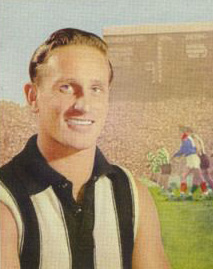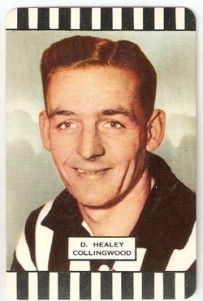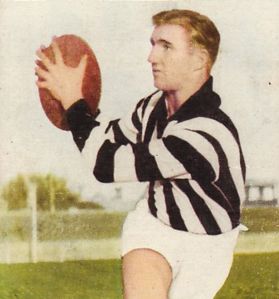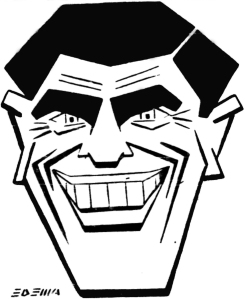Archive for the ‘The Players’ Category
They All Played Their Part
Jack Hamilton
Debut – 1948
Retired – 1957
Games – 154
Goals – 16
Missed 1953 Grand Final due to injury
Jack was one of the best full-backs that Collingwood has had since World War II, he unluckily missed the 1953 Grand Final after breaking his scaphoid bone in the round 14 clash against Geelong, four weeks before the start of the finals.
Hamilton was a tough and ruthless fitness fanatic who was one of the first players of his era to lift weights as a way of improving strength.
He later went on to a career in football administration, becoming chief commissioner of the VFL in 1984. He was killed in a car accident in May 1990, the year in which Collingwood would finally break their 32 year premiership drought.
Maurice Dunstan
Debut – 1949
Retired – 1954
Games – 72
Goals – 118
‘Mocha’ played in the forward line for most of the 1953 season, although he was said to be quite an unreliable shot for goal. He scored 22 goals for the season out missed the finals due to an injury sustained in the final home & away match against Footscray. He also missed rounds 2- 5 with injury that season.
Maurice Dunstan is perhaps best known for having a son, Ian, who played 172 games for Footscray.
Jack Hickey
Debut – 1951
Retired – 1956
Games – 72
Goals – 15
Jack Hickey was dropped from the side after the semi-final win over Geelong after playing 17 games for the 53 season.
Frank Tuck
 Debut – 1950
Debut – 1950
Retired – 1959
Games – 131
Goals – 34
Captain – 1958-59
Dave Little
Debut – 1953
Retired – 1955
Games – 10
Goals – 1
Dave Little came to Collingwood from Korrumburra at the beginning of the 1953 season with lots of hype that he never lived up to. He played only 3 games in 1953.
Peter Lucas
Debut – 1949
Retired – 1959
Games – 177
Goals – 1
Peter Lucas missed both the 1952 & 53 Grand Finals through injury. He was a fine half-back-flanker who could block the most talented forwards in the VFL. He was not very flamboyant but he was consistent. He played in the 1958 premiership team.
Kevin Clarke
Debut – 1953
Retired – 1954
Games – 18
Goals – 7
Bill Tebble
Debut – 1950
Retired – 1953
Games – 57
Goals – 8
Was a defender who played either back-pocket or centre-half-back. Kicked all his career goals in 1953 when he was shifted to the forward line in Bill Twomey’s absence early in the season.
Kevin Flint
Debut – 1952
Retired – 1953
Games – 4
Goals – 3
Tom Tarrant
Debut – 1953
Retired – 1954
Games – 7
Goals – 1
Pat Milburn
Debut – 1953
Games – 6
Goals – 3
Fred West
Debut – 1950
Retired – 1953
Games – 17
Goals – 4
Keith Bromage
Debut – 1953
Retired – 1961
Games With Collingwood (1953-56) – 28
Games With Fitzroy (1958-61) – 41
Total Games – 69
Goals for Collingwood – 30
Goals for Fitzroy – 48
The youngest player to ever play league football when he debuted in round 17 against Richmond. He was just 15 years of age.
Barry Taylor
Only game was the 1953 ANZAC Exhibition Match against Fitzroy. There is no evidence of him ever playing a senior match.
Wrestling With The Weed
 In 1953 Murray Weideman was the youngest member of Collingwood’s premiership team at just 17 years of age. Even though he spent the match on the bench, it would be just 5 years later when he would be acting captain in another great Magpie premiership, where his intimidation of Melbourne great Ron Barrasi was an important factor in Collingwood’s 1958 success, but it is another much stranger issue that I’d like to focus on here. How good was Murray Weideman the professional wrestler?
In 1953 Murray Weideman was the youngest member of Collingwood’s premiership team at just 17 years of age. Even though he spent the match on the bench, it would be just 5 years later when he would be acting captain in another great Magpie premiership, where his intimidation of Melbourne great Ron Barrasi was an important factor in Collingwood’s 1958 success, but it is another much stranger issue that I’d like to focus on here. How good was Murray Weideman the professional wrestler?
In August 1962 Murray Weideman shocked both Collingwood and the football world by deciding to combine his football with a career in professional wrestling. Collingwood were out of finals contention at this time, although the Magpies came very close to stripping Weideman of the club captaincy. Seeing how wrestling was portrayed as a very violent sport, and the fact that in 1962 most people thought that everything that happened in the ring was real, the Magpies were concerned that Weideman would badly injure himself in this new pursuit, as he’d already suffered a should injury in a match in July against Hawthorn. It was not until Weideman broke kafabe, and told them that the only likelihood of him being hurt while wrestling would be if he did not fall the way in which he was taught, that Collingwood allowed him to get in the ring. (However even though pro-wrestling is ‘not real’, wrestlers do still get hurt!) Weideman also told them that he could make ten times the amount of money for one nights wrestling than he could playing a match for the Pies.
The ‘Weed’s’ career in the squared circle only seemed to last two months, and usually featured Weideman partnering Salvatore Savoldi in tag team action against the heelish George Bollas (best known for wrestling under a mask as the Zebra Kid) and Paul ‘the Butcher’ Vachon. Whenever Bollas was wrestling singles matches under his mask, Pierre La Chapelle would partner Vachon. Weideman also did a wrestling work-out on Channel 9’s the Tony Charlton Show against ex-wrestler ‘Dirty’ Dick Raines. Raines, one of the most hated heels ever to get in the ring, often acted as a referee in the Weideman/Savoli vs Bollas/Vachon (La Chappelle) matches, so it was no surprise that they often ended in chaos with the bad guys coming out on top despite their dirty tactics. Weideman also featured in a Battle Royal match. Some of the matches were also televised on Channel 7.
The ‘Weed’ claims he had offers to wrestle in America but decided to stay at home to concentrate on his footy but was he really this good? In the early 60s wrestling in Australia was in decline and there is no doubt that Weideman was used by the Americans simply as a drawcard to get punters to come to the Melbourne Stadium to watch them grapple. He was probably the most polarizing figure in Melbourne at that time, being adored by Magpie fans but loathed by everyone else and could have worked as either a villainous heel or a face. Collingwood fans loved him as a tough guy enforcer on the football field, but opposition supporters loathed him for it. In 1959 an angry fan fired a warning shop at Weideman while he was in an Alphington milkbar. (For those curious enough, the bullet hole is still visible in the window of what is now the Apte restaurant at 338-340 Heidelberg Road in Alphington!) It seems that Weideman worked only as a face and that most people who attended the wrestling matches were Collingwood supporters. There were even reports in the newspaper of fans singing ‘Good Old Collingwood Forever‘ when Weideman made his way to the ring one night!
But was he good enough to wrestle in America? Probably not. From the video attached he seems to be extremely green have only the most basic skill level, which is unsurprising since he probably only had a few grappling lessons before getting in the ring. All of the wrestlers that Weideman got into the ring with had many years of experience and would have wanted to make the ‘Weed’ look good, and in wrestling you are really only as good as your opponent allows you to be. I am sure they would have all wanted him to look like a million dollars in front of his adoring Magpie fans.
What is surprising is that it was less than two years after Weideman got into the ring that wrestling started booming in Australia, but Weideman was not a part of this boom. World Championship Wrestling started in 1964 and brought in great some American and international wrestlers to mix it with the best Aussies, and at the end of 1963 Weideman had retired from football, so he would have been free to pursue a full-time career as a grappler, yet to my knowledge he was not approached to be a part of WCW.
I guess like wrestler (or footballer) worth his salt, the ‘Weed’ over-exaggerated when he talked about his wrestling career and how good he was in the ring. Anyone who has ever listened to Hulk Hogan, Ric Flair or Bret Hart when interviewed about their career knows that most wrestlers use a lot of braggadocio when talking about their greatness in the ring and I suspect that this was also the case with Weideman.
Des Healey
 Debut – 1948
Debut – 1948
Retired – 1955
Games – 149
Goals – 27
1955 Copeland Trophy
1951 & 1954 R. T. Rush Trophy
1953 J. J. Joyce Trophy
Seconds Best and Fairest: 1947
Interstate Representative: 1949, 1953 (carnival)
All-Australian – 1953
Coach under 19s – 1972-77
Member of Collingwood’s Hall of Fame (Inducted 2006)
Des Healey was a brilliant and attacking wingman whom both Phonse Kyne and Lou Richards regarded as the best winger Collingwood had ever produced, whilst Essendon legend John Coleman described Healey as the best wingman he had ever seen in the game. Coleman praised him by saying, “He is clever, has that wonderful tenacity of all good Collingwood players, and is tireless.” His teammate Bill Twomey Jr. said that Healey was the cleverest player he had ever seen in one on one duels, whilst Bob Rose said that Healey was a top class player who had everything. Richmond’s duel Brownlow Medalist Roy Wright called Des the gamest player he had ever seen and that he had a lot of courage for someone who was just 5’6″. “If he were a big man he would kill someone the way he tears through packs” Wright said. Along with fellow left-footers Bill Twomey and Thorold Merrett Healey was a part of one of the best centrelines of the era.
The tenacious Healey was small and fast and a great stab-kick off his left boot. He also possessed a safe pair of hands as he was a great mark. He showed dazzling speed in the way he cashed the ball and could keep control of it with uncanny ability. His evasive skills were superb. Healey worked long and hard perfecting his talent. He often spent extra nights alone on the training track twisting and turning around imaginary opponents at top pace. His unrivalled commitment was inspiration for all.
1953 was a stand out year for Healey, as he won All-Australian selection and was judged by many observers to be best on ground in Collingwood’s premiership win. He was third in the Copeland Trophy behind Bob Rose and Neil Mann.
Unfortunately today Healey is most well-known for the last game in which he played, the 1955 Grand Final loss to Melbourne. In one of the most talked about incidents in Grand Final history and with three minutes to go in the match, Healey collided with Melbourne’s Frank ‘Bluey’ Adams who had just run onto the ground from the bench. Healey, who had been the Magpie’s best player to that point, had his nose broken, skull fractured and was severely concussed. Despite winning the Copeland Trophy that year he never played another game saying ‘I could not stand another blow like that. He was just 27.
Healey was also an outstanding cricketer who in the 1953-54 season was a part of Collingwood’s first grade district cricket team. In the 1952-53 season he was a part of the Magpies’ second XI team where he topped the batting averages and won the club championship. He top scored in the final match of the season with 92 runs against South Melbourne. Two years earlier both Healey and Merrett were team-mates in Collingwood’s 1951 Third XI team that won the cricket final against Prahran. They put on a 151 run partnership to set up their victory, with Healey scoring a century and Merrett making 51.
In the late 70s Des spent six years as coach of Collingwood’s under 19 team, nuturing young talent such as Peter Daicos. Healey passed away in 2009 aged 81.
____________________________________________________________
Acknowledgements
- Roberts. M & McFarlane. G -The Official Collingwood Illustrated Encyclopedia – Updated Edition – 2010 The Slattery Media Group
- Holmesby R & Main J. – The Encyclopedia Of AFL Footballers – Seventh Edition – 2007 Bas Publishing
- Main. J – When It Matters Most – 2006 Bas Publishing
- Collingwood Football Club Website – http://www.afl.com.au/Season2007/News/NewsArticle/tabid/5586/Default.aspx?newsId=7022
- Carlyon. G – Gordon Carlyon’s Scrapbook Number 2 – 2002 Gordon Carlyon
- Roberts. M – A Century Of The Best – The Stories of Collingwood’s Favourite Sons – 1991 Collingwood Football Club
Lou Richards
Debut – 1941
Retired – 1955
Games – 250
Goals – 423
Captain – 1952-1955
Collingwood’s Leading Goalkicker – 1944, 1948, 1950
R.T. Rush Trophy – 1947, 1950 (Runner Up Best & Fairest)
J.J. Joyce Trophy – 1951 (3rd Best & Fairest)
Member of Collingwood’s Hall of Fame (Inducted 2004)
Out of all the champions who have donned the famous black & white jumper Lewis Thomas Charles Richards is perhaps the most famous of all. Unfortunately it is for his deeds off the ground, as football’s first multi-media star that Lou is remembered rather than his great contributions to the Magpies as a player and premiership captain. While Lou never won a Copeland Trophy he was placed three times, coming runner-up in 1947 and 1950 and third in 1951. He also led Collingwood’s goalkicking on three occasions in 1944, 48 and 50. In 1947 he was named the Herald’s Player of the Year. In that year he also polled the most Brownlow Medal votes of all the Magpies (10) to finish 14th. Phonse Kyne who won that year’s Copeland Trophy finished a further three votes behind Lou, as did teammates Ray Horwood and Ray Stokes. With the exception of the 1953 premiership year in which he did not poll a single vote, Lou was usually one of Collingwood’s best polling players on Brownlow night.
While Lou was an immensely courageous rover with a ton of cheek, who was rugged, tough and determined. He also was ferociously competitive and had a fierce will to win. In 1951 on Phonse Kynes’s retirement as a player he forced his brother Ron to nominate him for the captaincy of the Magpies, but was overwhelmingly rejected in favour of Gordon Hocking. Neil Mann was appointed vice-captain to Hocking, something which really annoyed Lou as he did not have the experience of Richards. However rather than dwell on this misfortune he decided to reflect on what he perceived as his biggest flaw, his open criticism of his teammates, both on and off the field. Lou decided to change his style and became encouraging rather than critical and by 1952 he was appointed captain after filling in for Hocking and Mann on occasion in 1951. Des Healey claimed Lou was the best captain he had played under saying that “He was a magnificent team man and a real great Collingwood player – he culd almost win matches for Collingwood on his own by getting the other players in. Thorold Merrett claimed, “He was always firing you up, telling you to get up if you were hurt and urging you from start to finish.” whilst his deputy Neil Mann said “Louie was a terrific captain, always giving you lots of encouragement.” Bob Rose rated Lou as the best rover of his era, alongside Essendon’s Bill Hutchison and Fitzroy’s Alan Ruthven. Lou’s greatest triumph was leading the team to premiership glory in 1953.
 After retiring from the game in 1955 Lou was given two options. The first was to coach Collingwood’s seconds with a view to becoming senior coach some time in the future, while the second was to join the media and to write articles for the Argus. Deferring the decision to his beloved wife Edna, Lou decided to set himself on the road to multi-media mega-stardom by refusing the coaching job and writing for the Argus. Despite his reservations Lou proved a natural, which shouldn’t have surprised anyone since during his playing career he was a media darling, giving extensive interviews for all of Melbourne’s daily newspapers on occasions. He was also a favourite of newspaper cartoonists such as The Age’s Sam Wells and The Herald’s WEG, who often depict him as a loud-mouthed chimpanzee. He would go onto being the game’s greatest media personality on radio, television and the newspapers.
After retiring from the game in 1955 Lou was given two options. The first was to coach Collingwood’s seconds with a view to becoming senior coach some time in the future, while the second was to join the media and to write articles for the Argus. Deferring the decision to his beloved wife Edna, Lou decided to set himself on the road to multi-media mega-stardom by refusing the coaching job and writing for the Argus. Despite his reservations Lou proved a natural, which shouldn’t have surprised anyone since during his playing career he was a media darling, giving extensive interviews for all of Melbourne’s daily newspapers on occasions. He was also a favourite of newspaper cartoonists such as The Age’s Sam Wells and The Herald’s WEG, who often depict him as a loud-mouthed chimpanzee. He would go onto being the game’s greatest media personality on radio, television and the newspapers.
In Collingwood’s 2010 premiership year Lou was once again in the headlines over the AFL’s refusal to elevate him to Legend status in the AFL’s Hall of Fame. The AFL argued that due to their rules which states Legends must be players and coaches at the “very pinnacle” of the game onfield, despite being one of the few to have captained Collingwood to a premiership and despite being the most-loved and greatest character that the game has produced.
___________________________________________________________
Acknowledgements
- Roberts. M & McFarlane. G -The Official Collingwood Illustrated Encyclopedia – Updated Edition – 2010 The Slattery Media Group
- Holmesby R & Main J. – The Encyclopedia Of AFL Footballers – Seventh Edition – 2007 Bas Publishing
- Richards L. & Phillips S.- The Kiss Of Death – 1989
- Stevens M. – Lou Richards rejects AFL Hall of Fame offer – http://www.heraldsun.com.au/news/its-all-or-nothing/story-0-1225713271416
- Carlyon. G – Gordon Carlyon’s Scrapbook Number 2 – 2002 Gordon Carlyon
- Roberts. M – A Century Of The Best – The Stories of Collingwood’s Favourite Sons – 1991 Collingwood Football Club




